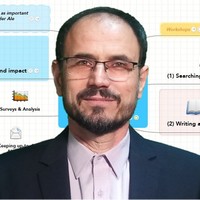Papers by Giacomo Mazzini

Mathematical Models and Methods in Applied Sciences, 2000
Recent developments in mechanics of continua (the search for optimal shapes of bodies, homogeniza... more Recent developments in mechanics of continua (the search for optimal shapes of bodies, homogenization theory, the study of the trabecular structure of bones, the dynamics of immiscible mixtures, etc.) render some of the introductory axioms of continuum mechanics inadequate. Not only does one need to give meaning to the join and meet of two bodies, but also to extend the consequent algebra so as to encompass the result of a countable sequence of operations of join or meet; and one should also be able to define the limit of a sequence of bodies. To achieve this goal we propose here to define a body ab initio through the assignment of a probability measure dπ. We realize that π leaves, generally, too much of the texture of the body unspecified; to make up for this deficiency, we suggest the use of appropriate texture measures, reminescent of Tartar's H-measures.9
Recent developments in mechanics of continua the search for optimal shapes of bodies, homogenizat... more Recent developments in mechanics of continua the search for optimal shapes of bodies, homogenization theory, the study of the trabecular structure of bones, the dynamics of immiscible mixtures, etc. render some of the introductory axioms of continuum mechanics inadequate. Not only does one need to give meaning to the join and meet of two bodies, but also to extend the consequent algebra so as to encompass the result of a countable sequence of operations of join or meet; and one should also be able to de ne the limit of a sequence of bodies. To a c hieve this goal we propose here to de ne a body ab initio through the assignement of a probability measure d . W e realize that leaves, generally, t o o m uch of the texture of the body unspeci ed; to make up for this de ciency, we suggest use of appropriate texture measures, reminescent o f T artar's H-measures 9 .

Within the framework of "one-stop desk points" -still a complex challenge for both traditional an... more Within the framework of "one-stop desk points" -still a complex challenge for both traditional and electronic government -an infrastructural and functional architecture is proposed for e-bureau networks, where information and transaction services have to be distributed and their legal validity has to be guaranteed. An outlook is given of faced problems and proposed solutions to fulfil the basic requirements of such "administrative portals". Whereas performance can be deferred to secondary technological improvements, development prospects impose at least protection of data integrity and authentication of communications, besides high architectural scalability, flexibility and interoperability with legacy systems, software platform independence. Moreover, information -distributed in a scaleable manner -has to be widely and easily accessible, consistently available, standardised and structured.

When several institutions are involved in a bureaucratic procedure, the associated workflow usual... more When several institutions are involved in a bureaucratic procedure, the associated workflow usually results from integrating procedural building blocks that are defined by laws currently in force: each block defines actors, actions and document flows, which must be included in the global paperwork if specific conditions apply. Thus, even before getting tools to manage workflow and to distribute it among subjects over a network, public administration can expect a valid contribution from information technology in modelling meta-procedures, as processes that select and assemble procedures. The effectiveness of results depends on how extensively a wealth of administrative knowledge -often dispersed across different practices and personal experiences -can be implemented into flexible information structures. To this end, special approaches have been tested in describing and classifying the available procedural information: as a result, a standard compliant workflow management system has been designed, which allows to configure a smart interactive procedure builder. A prototype has been validated in various EU countries, that provides enough flexibility in configuration and usage to support operations of public one-stop shops.










Uploads
Papers by Giacomo Mazzini